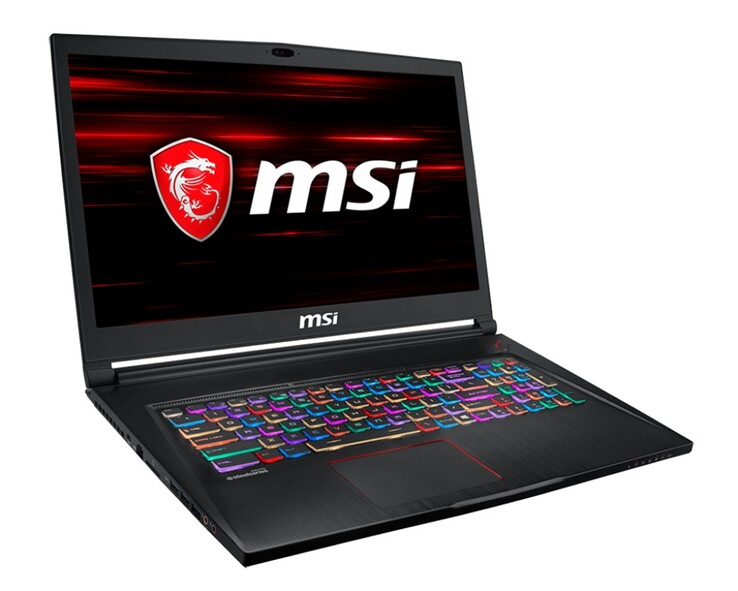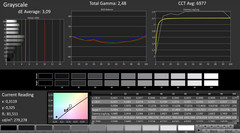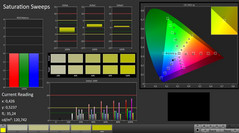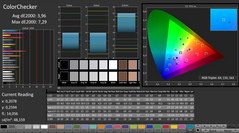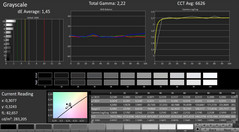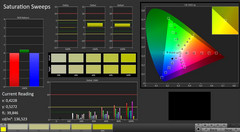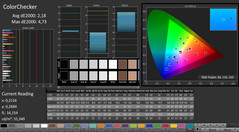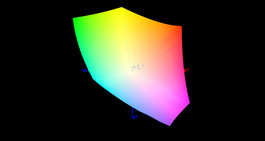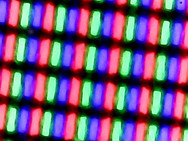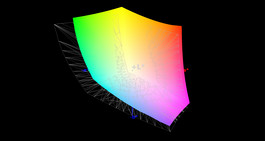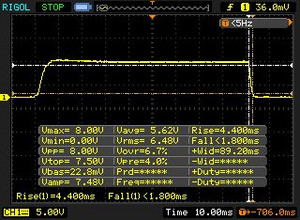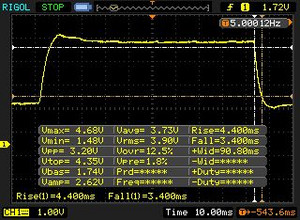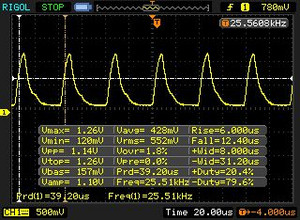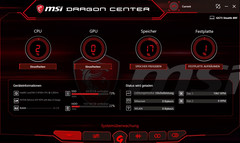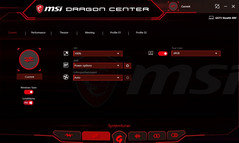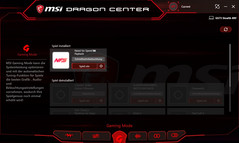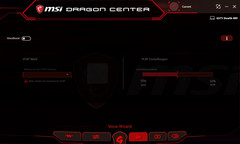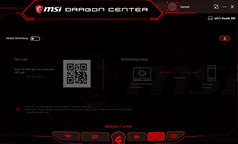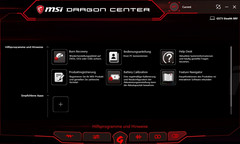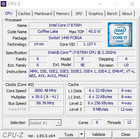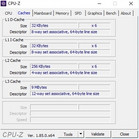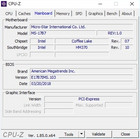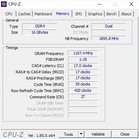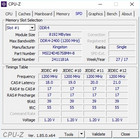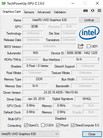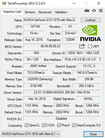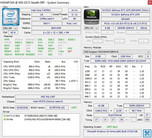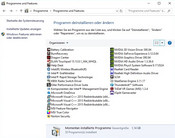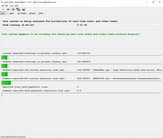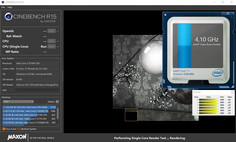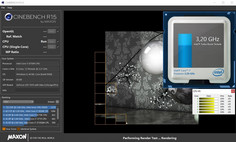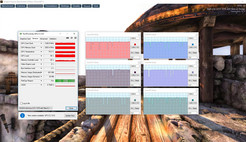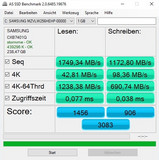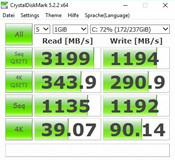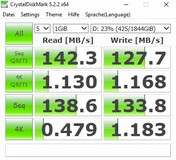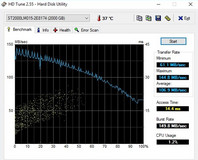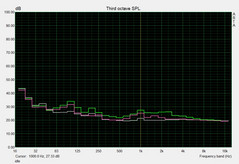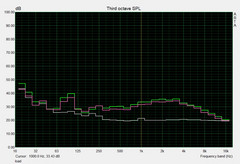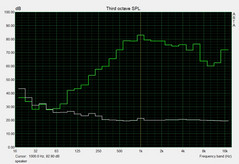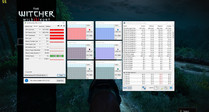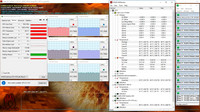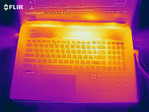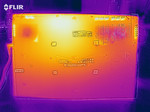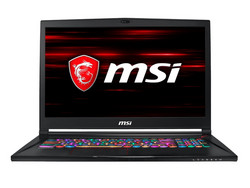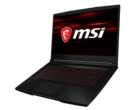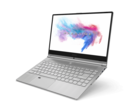MSI GS73 8RF Stealth (i7-8750H, GTX 1070 Max-Q, FHD) Laptop Review

While the 15-inch GS63 was replaced by the stylish GS65 in Intel's Coffee-Lake generation, MSI remains faithful to the established case in the 17-inch model. With the exception of the improved connections (now 2x USB 3.1 Gen2 instead of the earlier 1x USB 3.1 Gen2), nothing has changed in the case according to our information. So rather than repeating the evaluation of the corresponding test categories (Case, Connections, Input Devices), after a short intro including a model overview, we will begin directly with the display. You can find out about the missing sections in the reviews of the predecessor and the model preceding that.
Unlike many other MSI laptops that have dozens of equipment variations, the new GS73 is only available in two versions whose base specifications are the same – at least as far as it concerns the German market. The GS73 8RF-011 and the GS73 8RF-010DE both cost 2200 to 2300 Euros (~$2559-2675; about $2300 in the US) and bring a Core i7-8750H, a GeForce GTX 1070 Max-Q, and 16 GB of DDR4-RAM. Data is stored either on the small 256 GB M.2-SSD or the large 2 TB 2.5-inch HDD. The display is a matte Full-HD TN screen with 120 Hz. Theoretically, the high-end product should also be available with a 4K display (available in the US for ~$2600). The manufacturer's home page lists a UHD IPS panel.
The competitors of the MSI GS73 8RF Stealth include other slim 17-inch gaming notebooks such as the Aorus X7 v7, the Medion Erazer X7857, or the in-house GE73 8RF. The latter each have a GTX 1070 without Max-Q design.
| SD Card Reader | |
| average JPG Copy Test (av. of 3 runs) | |
| Aorus X7 v7 (Toshiba Exceria Pro SDXC 64 GB UHS-II) | |
| MSI GS73VR 7RG (Toshiba Exceria Pro SDXC 64 GB UHS-II) | |
| MSI GS73 Stealth 8RF-011 (Toshiba Exceria Pro SDXC 64 GB UHS-II) | |
| Average of class Gaming (20 - 210, n=71, last 2 years) | |
| MSI GE73 8RF-008 Raider RGB (Toshiba Exceria Pro SDXC 64 GB UHS-II) | |
| maximum AS SSD Seq Read Test (1GB) | |
| Aorus X7 v7 (Toshiba Exceria Pro SDXC 64 GB UHS-II) | |
| MSI GS73 Stealth 8RF-011 (Toshiba Exceria Pro SDXC 64 GB UHS-II) | |
| MSI GS73VR 7RG (Toshiba Exceria Pro SDXC 64 GB UHS-II) | |
| Average of class Gaming (25.5 - 261, n=67, last 2 years) | |
| MSI GE73 8RF-008 Raider RGB (Toshiba Exceria Pro SDXC 64 GB UHS-II) | |
| Networking | |
| iperf3 transmit AX12 | |
| Medion Erazer X7857 | |
| MSI GE73 8RF-008 Raider RGB | |
| Aorus X7 v7 | |
| MSI GS73VR 7RG | |
| MSI GS73 Stealth 8RF-011 | |
| iperf3 receive AX12 | |
| MSI GE73 8RF-008 Raider RGB | |
| MSI GS73VR 7RG | |
| Aorus X7 v7 | |
| MSI GS73 Stealth 8RF-011 | |
| Medion Erazer X7857 | |
Display - More Hertz for gamers
The are no surprises in the display. We already know the 120-Hz display with the label CMN N173HHE-G32 from the old GS73, where it has served well.
| |||||||||||||||||||||||||
Brightness Distribution: 94 %
Center on Battery: 262 cd/m²
Contrast: 1310:1 (Black: 0.2 cd/m²)
ΔE ColorChecker Calman: 3.96 | ∀{0.5-29.43 Ø4.77}
calibrated: 2.18
ΔE Greyscale Calman: 3.09 | ∀{0.09-98 Ø5}
100% sRGB (Argyll 1.6.3 3D)
76% AdobeRGB 1998 (Argyll 1.6.3 3D)
85.8% AdobeRGB 1998 (Argyll 3D)
99.9% sRGB (Argyll 3D)
90.8% Display P3 (Argyll 3D)
Gamma: 2.48
CCT: 6977 K
| MSI GS73 Stealth 8RF-011 CMN N173HHE-G32 (CMN1747), TN, 1920x1080 | MSI GS73VR 7RG ID: CMN1747, Name: Chi Mei N173HHE-G32, TN LED, 1920x1080 | MSI GE73 8RF-008 Raider RGB Chi Mei N173HHE-G32 (CMN1747), TN WLED, 1920x1080 | Aorus X7 v7 AU Optronics B173QTN01.4 (AUO1496), TN LED, 2560x1440 | Medion Erazer X7857 LG Philips LP 173WF4-SPF5, IPS, 1920x1080 | |
|---|---|---|---|---|---|
| Display | 0% | 0% | -23% | -25% | |
| Display P3 Coverage (%) | 90.8 | 89.6 -1% | 90.8 0% | 63 -31% | 65.3 -28% |
| sRGB Coverage (%) | 99.9 | 100 0% | 99.9 0% | 87.1 -13% | 83.4 -17% |
| AdobeRGB 1998 Coverage (%) | 85.8 | 86.9 1% | 85.8 0% | 63.7 -26% | 61 -29% |
| Response Times | -119% | -189% | -103% | -312% | |
| Response Time Grey 50% / Grey 80% * (ms) | 7.8 ? | 23.6 ? -203% | 28 ? -259% | 24 ? -208% | 34 ? -336% |
| Response Time Black / White * (ms) | 6.2 ? | 8.4 ? -35% | 13.6 ? -119% | 6 ? 3% | 24 ? -287% |
| PWM Frequency (Hz) | 25510 ? | 26040 ? | 25000 ? | 119000 ? | |
| Screen | -50% | -2% | -39% | -33% | |
| Brightness middle (cd/m²) | 262 | 350.9 34% | 273 4% | 375 43% | 413 58% |
| Brightness (cd/m²) | 261 | 311 19% | 273 5% | 353 35% | 376 44% |
| Brightness Distribution (%) | 94 | 79 -16% | 90 -4% | 85 -10% | 82 -13% |
| Black Level * (cd/m²) | 0.2 | 0.33 -65% | 0.26 -30% | 0.58 -190% | 0.6 -200% |
| Contrast (:1) | 1310 | 1063 -19% | 1050 -20% | 647 -51% | 688 -47% |
| Colorchecker dE 2000 * | 3.96 | 7.7 -94% | 3.52 11% | 6.06 -53% | 5.06 -28% |
| Colorchecker dE 2000 max. * | 7.29 | 14.4 -98% | 6.34 13% | 10.54 -45% | 9.33 -28% |
| Colorchecker dE 2000 calibrated * | 2.18 | 2.09 4% | |||
| Greyscale dE 2000 * | 3.09 | 11.1 -259% | 3.11 -1% | 5.68 -84% | 5.29 -71% |
| Gamma | 2.48 89% | 2.11 104% | 2.43 91% | 2.3 96% | 2.64 83% |
| CCT | 6977 93% | 11813 55% | 6999 93% | 7998 81% | 6766 96% |
| Color Space (Percent of AdobeRGB 1998) (%) | 76 | 77.74 2% | 76 0% | 57 -25% | 55 -28% |
| Color Space (Percent of sRGB) (%) | 100 | 100 0% | 100 0% | 87 -13% | 83 -17% |
| Total Average (Program / Settings) | -56% /
-49% | -64% /
-25% | -55% /
-45% | -123% /
-68% |
* ... smaller is better
Although the viewing angles are quite limited (in particular, vertically) due to the TN technology, the 17-inch display is able to score with a fast response time of 6.2 ms black-to-white and 7.8 ms gray-to-gray.
As another positive point, we should also mention the ample contrast. Thanks to its low black value (0.2 cd/m²), our test unit achieves almost 1300:1. However, the brightness could have been a bit better. While 260 cd/m² on average are sufficient most of the time indoors, the notebook will quickly reach its limits outdoors.
Since MSI makes the well-known True-Color-Software available on the GS73, the image can be adjusted comfortably to various scenarios. The sRGB mode active by default, strikes a good figure in terms of the color accuracy. The panel also deserves some praise for the first-class color space. 100% sRGB and 76% AdobeRGB are rare in gaming laptops.
Display Response Times
| ↔ Response Time Black to White | ||
|---|---|---|
| 6.2 ms ... rise ↗ and fall ↘ combined | ↗ 4.4 ms rise | |
| ↘ 1.8 ms fall | ||
| The screen shows very fast response rates in our tests and should be very well suited for fast-paced gaming. In comparison, all tested devices range from 0.1 (minimum) to 240 (maximum) ms. » 19 % of all devices are better. This means that the measured response time is better than the average of all tested devices (20.2 ms). | ||
| ↔ Response Time 50% Grey to 80% Grey | ||
| 7.8 ms ... rise ↗ and fall ↘ combined | ↗ 4.4 ms rise | |
| ↘ 3.4 ms fall | ||
| The screen shows very fast response rates in our tests and should be very well suited for fast-paced gaming. In comparison, all tested devices range from 0.165 (minimum) to 636 (maximum) ms. » 19 % of all devices are better. This means that the measured response time is better than the average of all tested devices (31.6 ms). | ||
Screen Flickering / PWM (Pulse-Width Modulation)
| Screen flickering / PWM detected | 25510 Hz | ≤ 14 % brightness setting | |
The display backlight flickers at 25510 Hz (worst case, e.g., utilizing PWM) Flickering detected at a brightness setting of 14 % and below. There should be no flickering or PWM above this brightness setting. The frequency of 25510 Hz is quite high, so most users sensitive to PWM should not notice any flickering. In comparison: 53 % of all tested devices do not use PWM to dim the display. If PWM was detected, an average of 8081 (minimum: 5 - maximum: 343500) Hz was measured. | |||
Performance - Slim, powerful package
Those looking for a slim 17-inch gaming notebook are at the right address with the GS73 Stealth. The combination of the Core i7-8750H and GeForce GTX 1070 Max-Q is able to handle demanding applications effortlessly. 16 GB of DDR4-RAM and an NVMe-SSD will also warrant a lot of future proofing.
Processor
Compared to the old Kaby-Lake models, the performance has improved significantly. With 1132 points in the multi-core test of Cinebench R15, the 17-incher surpasses the Core i7-7820HK of the Aorus X7 v7 by 40% and the Core i7-7700HQ of the predecessor by more than 50%.
On the other hand, Coffee-Lake devices are known for only being able to maintain their maximum performance for a short time. This is also the case for the GS73, as you can see in the chart below. In the Cinebench loop, the score drops by about 8% starting in the second run and about 13% from the third run, but then it remains fairly constant.
System Performance
The GS73 has absolutely no lack of system power. The Solid-State Drive in particular warrants high values in the benchmarks. Unfortunately, the 17-incher has to struggle with a typical problem that affects many laptops based on Optimus: particular actions such as right-clicks on the desktop or the file explorer result in short stutters that become very annoying in the long run. This is reminiscent of systems with HDD and is outmoded in 2018. You can find out more about this bug here.
| PCMark 8 | |
| Home Score Accelerated v2 | |
| Average of class Gaming (5564 - 5883, n=2, last 2 years) | |
| Medion Erazer X7857 | |
| Aorus X7 v7 | |
| MSI GE73 8RF-008 Raider RGB | |
| MSI GS73VR 7RG | |
| MSI GS73 Stealth 8RF-011 | |
| Work Score Accelerated v2 | |
| MSI GE73 8RF-008 Raider RGB | |
| MSI GS73 Stealth 8RF-011 | |
| Aorus X7 v7 | |
| MSI GS73VR 7RG | |
| Average of class Gaming (n=1last 2 years) | |
| PCMark 8 Home Score Accelerated v2 | 4393 points | |
| PCMark 8 Work Score Accelerated v2 | 5323 points | |
Help | ||
Storage
As already mentioned, the GS73 has a 256 GB M.2-SSD with PCIe/NVMe technology. Instead of a Samsung PM871 (GS73VR 7RG), MSI has installed a Samsung PM961 that surpasses most of the competing products in the new model. In our test field, only the Aorus X7 v7 offers an even faster SSD (Samsung SM961).
In order for the customers to avoid running out of space too quickly, the manufacturer has additionally built-in a 2.5-inch HDD from Seagate with a 2 TB capacity and 5400 RPM called BarraCuda ST2000LM015.
| MSI GS73 Stealth 8RF-011 Samsung PM961 MZVLW256HEHP | MSI GS73VR 7RG Samsung SSD PM871 MZNLN512HMJP | MSI GE73 8RF-008 Raider RGB Toshiba HG6 THNSNJ256G8NY | Aorus X7 v7 Samsung SM961 MZVPW256HEGL | Medion Erazer X7857 Samsung PM961 NVMe MZVLW512HMJP | |
|---|---|---|---|---|---|
| AS SSD | -49% | -68% | 20% | -39% | |
| Seq Read (MB/s) | 1749 | 497.9 -72% | 511 -71% | 2690 54% | 2188 25% |
| Seq Write (MB/s) | 1173 | 465.1 -60% | 425.7 -64% | 1067 -9% | 347.1 -70% |
| 4K Read (MB/s) | 42.81 | 33.69 -21% | 14.07 -67% | 48.35 13% | 45.19 6% |
| 4K Write (MB/s) | 98.4 | 96.8 -2% | 38.34 -61% | 123.3 25% | 1.02 -99% |
| Score Read (Points) | 1456 | 421 -71% | 417 -71% | 1803 24% | 1302 -11% |
| Score Write (Points) | 906 | 417 -54% | 254 -72% | 1021 13% | 106 -88% |
| Score Total (Points) | 3083 | 1064 -65% | 881 -71% | 3668 19% | 1990 -35% |
Graphics Card
While simple tasks are handled by the graphics chip of the processor, the GeForce GTX 1070 Max-Q is responsible for more computing-intensive 3D applications. The high-end model is based on Nvidia's Pascal architecture and was designed for extremely slim laptops.
| 3DMark - 1920x1080 Fire Strike Graphics | |
| Average of class Gaming (6487 - 62849, n=153, last 2 years) | |
| MSI GE73 8RF-008 Raider RGB | |
| Aorus X7 v7 | |
| MSI GS73VR 7RG | |
| MSI GS73 Stealth 8RF-011 | |
| 3DMark 11 - 1280x720 Performance GPU | |
| Average of class Gaming (13523 - 80022, n=140, last 2 years) | |
| MSI GE73 8RF-008 Raider RGB | |
| Medion Erazer X7857 | |
| Aorus X7 v7 | |
| MSI GS73VR 7RG | |
| MSI GS73 Stealth 8RF-011 | |
Even though the Max-Q version offers slightly less performance compared to the "regular" GTX 1070 (the Fire-Strike score of the 3DMark 13 turns out 20% lower than in the MSI GE63), noise-sensitive users should be pleased by less noise under load.
| 3DMark 11 Performance | 15894 points | |
| 3DMark Cloud Gate Standard Score | 32221 points | |
| 3DMark Fire Strike Score | 12624 points | |
Help | ||
We are pleased that the Turbo of the GTX 1070 Max-Q is also very effective during longer load periods. After 60 minutes of "The Witcher 3," the core levels out at about 1228 MHz (basic clock speed: 1101 MHz, maximum speed: 1544 MHz), although other Max-Q laptops achieve even higher average values.
Gaming Performance
Passionate gamers will be very pleased with the Full-HD option. The GeForce GTX 1070 Max-Q is powerful enough to display even modern 3D games smoothly in the native resolution with high to maximum detail. The cases where it hits its limit are the exception (for example, in "Final Fantasy 15").
| The Witcher 3 - 1920x1080 Ultra Graphics & Postprocessing (HBAO+) | |
| Average of class Gaming (18.4 - 240, n=53, last 2 years) | |
| MSI GE73 8RF-008 Raider RGB | |
| Aorus X7 v7 | |
| Medion Erazer X7857 | |
| MSI GS73VR 7RG | |
| MSI GS73 Stealth 8RF-011 | |
The advantages of the 120-Hz technology can be felt primarily in less demanding games such as "FIFA 18," where the laptop achieves more than 100 FPS.
| low | med. | high | ultra | |
|---|---|---|---|---|
| The Witcher 3 (2015) | 91.6 | 49.6 | ||
| For Honor (2017) | 121 | 94.2 | ||
| Ghost Recon Wildlands (2017) | 75.7 | 42.8 | ||
| FIFA 18 (2017) | 223 | 214 | ||
| Assassin´s Creed Origins (2017) | 71 | 61 | ||
| Need for Speed Payback (2017) | 94.2 | 86.2 | ||
| Star Wars Battlefront 2 (2017) | 86.4 | 73.9 | ||
| Fortnite (2018) | 113 | 96.1 | ||
| Final Fantasy XV Benchmark (2018) | 47.8 | |||
| Far Cry 5 (2018) | 76 | 72 | ||
| The Crew 2 (2018) | 60 | 60 | ||
| F1 2018 (2018) | 110 | 76 |
Emissions - Not loud, but warm
Noise Emissions
Due to the Max-Q design, the GS73 does not get too loud under load. While 43-45 dB(A) in 3D operation are by no means quiet, it is still relatively little for a high-end notebook, particularly when looking at the competitors who often reach for the 50-dB(A) mark or even exceed it.
During gentle demands, the 17-incher leaves a mixed impression. While the fans are often completely turned off during idle mode, during simple or medium-level tasks such as Windows updates or starting up applications, they tend to rev up towards 40 dB(A). However, the GS73 still belongs to the more quiet gaming notebooks overall.
Noise level
| Idle |
| 30 / 34 / 36 dB(A) |
| HDD |
| 34 dB(A) |
| Load |
| 43 / 45 dB(A) |
 | ||
30 dB silent 40 dB(A) audible 50 dB(A) loud |
||
min: | ||
| MSI GS73 Stealth 8RF-011 i7-8750H, GeForce GTX 1070 Max-Q | MSI GS73VR 7RG i7-7700HQ, GeForce GTX 1070 Max-Q | MSI GE73 8RF-008 Raider RGB i7-8750H, GeForce GTX 1070 Mobile | Aorus X7 v7 i7-7820HK, GeForce GTX 1070 Mobile | Medion Erazer X7857 i7-7820HK, GeForce GTX 1070 Mobile | Average of class Gaming | |
|---|---|---|---|---|---|---|
| Noise | 3% | -3% | -6% | -3% | 8% | |
| off / environment * (dB) | 30 | 28 7% | 30 -0% | 30 -0% | 30.3 -1% | 24.1 ? 20% |
| Idle Minimum * (dB) | 30 | 29.4 2% | 32 -7% | 33 -10% | 31.3 -4% | 26 ? 13% |
| Idle Average * (dB) | 34 | 30.7 10% | 33 3% | 36 -6% | 31.7 7% | 27.6 ? 19% |
| Idle Maximum * (dB) | 36 | 34 6% | 34 6% | 41 -14% | 31.7 12% | 30.2 ? 16% |
| Load Average * (dB) | 43 | 42 2% | 41 5% | 41 5% | 48.3 -12% | 43 ? -0% |
| Witcher 3 ultra * (dB) | 45 | 45.8 -2% | 50 -11% | 45 -0% | 50.6 -12% | |
| Load Maximum * (dB) | 45 | 45.8 -2% | 54 -20% | 52 -16% | 49.6 -10% | 53.8 ? -20% |
* ... smaller is better
Temperature
Unfortunately the moderate noise development is at the expense of the temperature. At a maximum of 58 °C (136 °F) on top and 63 °C (145 °F) on the bottom, the case becomes extremely hot in 3D operation. We generally advise against gaming sessions on your lap. Things look much better in idle operation, where the case remains below 30 °C (86 °F) most of the time.
Now we take a look at the components that heat up most during full load on the CPU and GPU: after 60 minutes of the stress test with the FurMark and Prime95 tools, the GeForce GTX 1070 Max-Q heats up to 87 °C (189 °F) despite throttling. Around 95 °C (203 °F) for the Core i7-8750H are also hefty. While gaming, you can expect about 80 °C (176 °F, see screenshot above).
(-) The maximum temperature on the upper side is 58 °C / 136 F, compared to the average of 40.4 °C / 105 F, ranging from 21.2 to 68.8 °C for the class Gaming.
(-) The bottom heats up to a maximum of 63 °C / 145 F, compared to the average of 43.3 °C / 110 F
(+) In idle usage, the average temperature for the upper side is 28.6 °C / 83 F, compared to the device average of 33.9 °C / 93 F.
(-) Playing The Witcher 3, the average temperature for the upper side is 47.1 °C / 117 F, compared to the device average of 33.9 °C / 93 F.
(-) The palmrests and touchpad can get very hot to the touch with a maximum of 41 °C / 105.8 F.
(-) The average temperature of the palmrest area of similar devices was 28.8 °C / 83.8 F (-12.2 °C / -22 F).
| MSI GS73 Stealth 8RF-011 i7-8750H, GeForce GTX 1070 Max-Q | MSI GS73VR 7RG i7-7700HQ, GeForce GTX 1070 Max-Q | MSI GE73 8RF-008 Raider RGB i7-8750H, GeForce GTX 1070 Mobile | Aorus X7 v7 i7-7820HK, GeForce GTX 1070 Mobile | Medion Erazer X7857 i7-7820HK, GeForce GTX 1070 Mobile | Average of class Gaming | |
|---|---|---|---|---|---|---|
| Heat | 8% | 7% | -1% | 11% | 8% | |
| Maximum Upper Side * (°C) | 58 | 52.2 10% | 47 19% | 51 12% | 46.2 20% | 45.7 ? 21% |
| Maximum Bottom * (°C) | 63 | 46.6 26% | 49 22% | 64 -2% | 42.2 33% | 48.5 ? 23% |
| Idle Upper Side * (°C) | 32 | 30.8 4% | 32 -0% | 33 -3% | 32.4 -1% | 31.3 ? 2% |
| Idle Bottom * (°C) | 30 | 32 -7% | 34 -13% | 33 -10% | 32.2 -7% | 34.3 ? -14% |
* ... smaller is better
Speakers
MSI GS73 Stealth 8RF-011 audio analysis
(+) | speakers can play relatively loud (89 dB)
Bass 100 - 315 Hz
(-) | nearly no bass - on average 21.6% lower than median
(±) | linearity of bass is average (9% delta to prev. frequency)
Mids 400 - 2000 Hz
(±) | higher mids - on average 6.4% higher than median
(+) | mids are linear (6.7% delta to prev. frequency)
Highs 2 - 16 kHz
(±) | reduced highs - on average 5% lower than median
(±) | linearity of highs is average (8.1% delta to prev. frequency)
Overall 100 - 16.000 Hz
(±) | linearity of overall sound is average (19.3% difference to median)
Compared to same class
» 65% of all tested devices in this class were better, 8% similar, 27% worse
» The best had a delta of 6%, average was 18%, worst was 132%
Compared to all devices tested
» 46% of all tested devices were better, 8% similar, 46% worse
» The best had a delta of 4%, average was 24%, worst was 134%
MSI GE73 8RF-008 Raider RGB audio analysis
(+) | speakers can play relatively loud (93 dB)
Bass 100 - 315 Hz
(±) | reduced bass - on average 7% lower than median
(±) | linearity of bass is average (8.1% delta to prev. frequency)
Mids 400 - 2000 Hz
(+) | balanced mids - only 4.8% away from median
(±) | linearity of mids is average (7.1% delta to prev. frequency)
Highs 2 - 16 kHz
(+) | balanced highs - only 3.6% away from median
(+) | highs are linear (4.6% delta to prev. frequency)
Overall 100 - 16.000 Hz
(+) | overall sound is linear (10.2% difference to median)
Compared to same class
» 5% of all tested devices in this class were better, 2% similar, 93% worse
» The best had a delta of 6%, average was 18%, worst was 132%
Compared to all devices tested
» 4% of all tested devices were better, 1% similar, 94% worse
» The best had a delta of 4%, average was 24%, worst was 134%
Power Management - Optimus vs. small battery
Power Consumption
During idle, the GS73 benefits a lot from the graphics switching. 8-22 watts are good values and make many competitors look bad. For example, the Aorus X7 v7 consumes 27-40 watts. Under load, the distances shrink considerably. The advantage of the lower consumption of the GeForce GTX 1070 Max-Q compared to the standard GTX 1070 is diminished by the hexa-core CPU, which uses more power than the old quad-core chips.
| Off / Standby | |
| Idle | |
| Load |
|
Key:
min: | |
| MSI GS73 Stealth 8RF-011 i7-8750H, GeForce GTX 1070 Max-Q | MSI GS73VR 7RG i7-7700HQ, GeForce GTX 1070 Max-Q | MSI GE73 8RF-008 Raider RGB i7-8750H, GeForce GTX 1070 Mobile | Aorus X7 v7 i7-7820HK, GeForce GTX 1070 Mobile | Medion Erazer X7857 i7-7820HK, GeForce GTX 1070 Mobile | Average of class Gaming | |
|---|---|---|---|---|---|---|
| Power Consumption | -1% | -32% | -87% | -47% | -35% | |
| Idle Minimum * (Watt) | 8 | 10.1 -26% | 15 -88% | 27 -238% | 20.6 -158% | 13.6 ? -70% |
| Idle Average * (Watt) | 14 | 18.3 -31% | 20 -43% | 33 -136% | 26 -86% | 19.4 ? -39% |
| Idle Maximum * (Watt) | 22 | 19.6 11% | 26 -18% | 40 -82% | 28 -27% | 26 ? -18% |
| Load Average * (Watt) | 92 | 87.6 5% | 97 -5% | 107 -16% | 95 -3% | 111.2 ? -21% |
| Witcher 3 ultra * (Watt) | 154 | 136.3 11% | 186 -21% | 190 -23% | 170 -10% | |
| Load Maximum * (Watt) | 207 | 160.7 22% | 239 -15% | 259 -25% | 197 5% | 261 ? -26% |
* ... smaller is better
Battery Life
The battery life of the GS73 is neither good nor particularly bad. Since MSI provides the 17-incher with only 51 Wh (94 Wh @Aorus X7 v7), the Optimus technology can only use its potential to a limited extent. While surfing on the internet via WLAN, our test unit positions itself in the middle of the field with about 3.5 hours of runtime. However, you have to be aware that as known from most laptops, the performance drops considerably in battery operation. Without the power supply, "The Witcher 3" runs almost 60% slower, since the CPU and GPU only reach about 1000 MHz.
| MSI GS73 Stealth 8RF-011 i7-8750H, GeForce GTX 1070 Max-Q, 51 Wh | MSI GS73VR 7RG i7-7700HQ, GeForce GTX 1070 Max-Q, 51 Wh | MSI GE73 8RF-008 Raider RGB i7-8750H, GeForce GTX 1070 Mobile, 51 Wh | Aorus X7 v7 i7-7820HK, GeForce GTX 1070 Mobile, 94 Wh | Medion Erazer X7857 i7-7820HK, GeForce GTX 1070 Mobile, 66 Wh | Average of class Gaming | |
|---|---|---|---|---|---|---|
| Battery runtime | -1% | -19% | -2% | 6% | 69% | |
| Reader / Idle (h) | 5.8 | 5.8 0% | 5.1 -12% | 3.7 -36% | 9.14 ? 58% | |
| WiFi v1.3 (h) | 3.3 | 3.2 -3% | 3.1 -6% | 3 -9% | 3.5 6% | 6.76 ? 105% |
| Load (h) | 1 | 1 0% | 0.6 -40% | 1.4 40% | 1.426 ? 43% | |
| H.264 (h) | 3.2 | 2.8 | 8.1 ? |
Verdict - Slim, slimmer, GS73
Pros
Cons
With the GS73 8RF Stealth, MSI is offering an extremely slim high-end notebook that continues to deliver a good performance, despite there only being few differences (the old model is almost identical).
The pretty aluminum case convinces with numerous connections and an RGB-illuminated keyboard. Apart from the viewing angles, the 120-Hz display also knows how to please. We can understand that MSI forgoes G-Sync and rather uses Optimus for increased mobility.
Further strengths include the fast card reader, the relatively low weight considering the 17-inch size, and the very high performance. Thanks to the Max-Q GPU, the noise development remains within limits. However, the case and hardware become extremely hot under full load. And MSI could also improve on the sound, since the sound quality turns out to be fairly weak.
Taking all the aspects together, we would rather recommend the GE73 for gaming fans. Even though the 17-inch sibling is about 1 cm (~0.4 in) thicker, it does slightly better overall.
MSI GS73 Stealth 8RF-011
- 08/24/2018 v6 (old)
Florian Glaser


